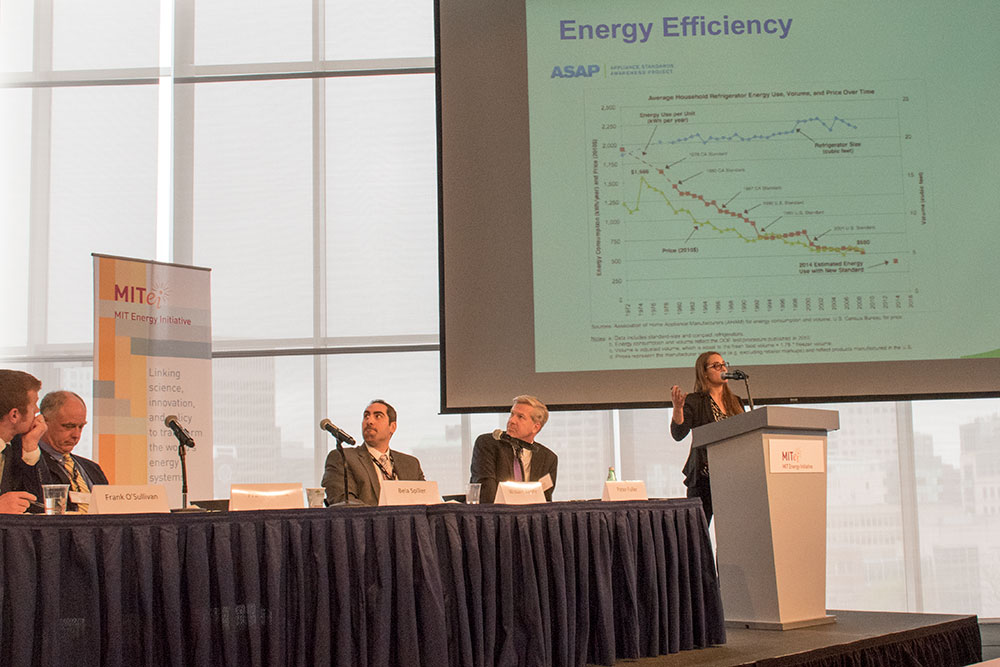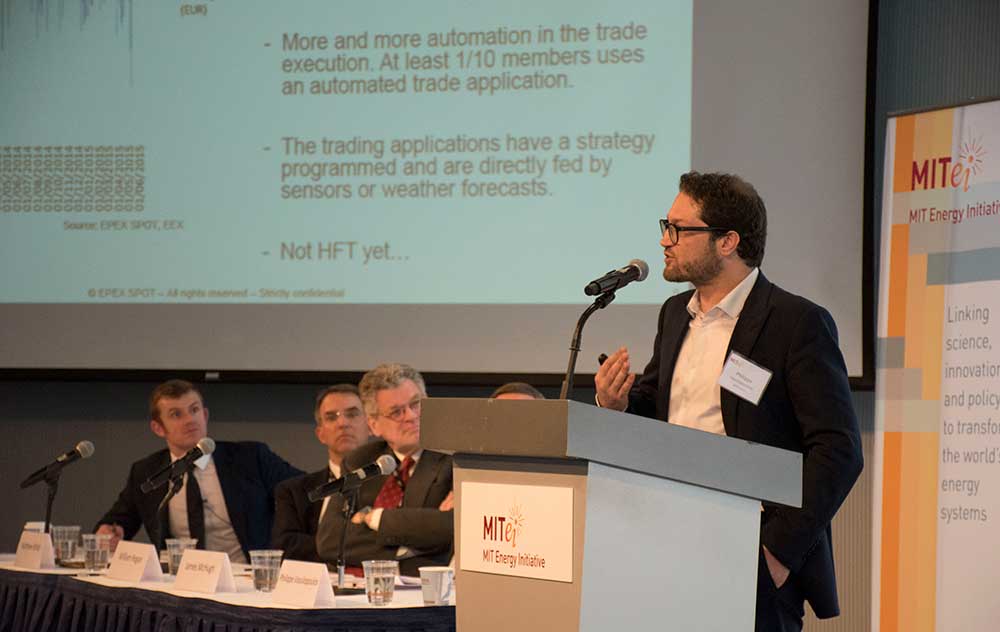
Technological developments and regulatory actions aimed at reducing greenhouse gas (GHG) emissions from electric power generation are reshaping today’s global electricity systems. Designing well functioning energy markets to meet the opportunities and challenges presented by the rise of low-carbon generation technologies like wind and solar photovoltaics is essential for the transition to a decarbonized energy system—and was the focus of a recent MIT Energy Initiative (MITEI) symposium for the Initiative’s members.
At the May 3 event, experts from industry and government joined MIT faculty and researchers to share their perspectives and experiences in developing real-world solutions to current energy market challenges. Speakers provided a detailed portrait of today’s energy markets’ strengths and weaknesses in achieving a low-carbon future. Participants discussed what the balance between centralized and distributed generation should be into the future, how to address the intermittency of wind and solar generation with energy storage, and how to expand electricity supply choices for consumers whilst continuing to deliver the economic and reliable electricity service that we have all grown to expect.
MITEI Director of Research and Analysis Francis O’Sullivan, who convened the event, said, “Recent dramatic cost reductions achieved with technologies like solar PV means that a new suite of compelling technical options for decarbonizing today’s power systems are available. The big challenge now is how to integrate these into existing power systems and market structures in a manner that is cost effective, and does not negatively impact overall system reliability.”

Philippe Vassilopoulos, head of product design at EPEX Spot, presents during a panel on energy markets.
Throughout a discussion on designing wholesale energy markets, participants stressed the importance of taking into account the ongoing shift toward generation from both centralized and distributed low-carbon energy technologies with zero-marginal cost of generation. They raised the possibility that structural changes may be required for energy markets to continue operating smoothly given these changes in the generation mix. One market design researcher added that where there are strong energy and capacity markets, systems might require only a few “targeted, technical enhancements in order to address the issue of renewables’ intermittency.” These, he said, include the better pricing of key system services like generation ramping capability (the ability to increase or decrease the power flowing through the system) and primary frequency response (a generator or other resource’s adjustment of its output to smooth large changes in frequency).
Another major concern articulated throughout the symposium was how to surmount barriers to implementing better markets. Visiting MITEI researcher Ignacio Perez-Arriaga discussed some opportunities for action from the distribution side. He suggested that one of the best choices for the energy system would be “integrating all interconnected markets” and “avoiding regulatory interferences with prices.” In his ideal setup, “all resources would compete and collaborate, accounting for a complete representation of network effects.”
In the symposium’s closing panel, Richard Schmalensee, the Howard W. Johnson Professor of Economics and John C. Head III Dean Emeritus at the MIT Sloan School of Management, echoed a sentiment many had expressed throughout the day: the importance of implementing carbon pricing. “Obviously we should price carbon, and if you want to price carbon, you should be a fan of tax reform,” he said.
One of Schmalensee’s fellow panelists praised the symposium’s focus on examining past failures and successes of energy markets to shape the future. “We should pay more attention to learning from the past,” he said. “One really good ex-poste analysis is worth twenty ex-ante analyses.”
Another panelist in the concluding session looked to the future and how the Internet of Things would affect energy systems. “We are moving from electricity selling to usage selling,” she said. Digitization of energy systems, she explained, allows for personalization and specificity in terms of how consumers use electricity and how they purchase it. She also addressed the sense of community that infused the events of the day. She said, “I really enjoyed this workshop, hearing all of the discussion and dialogue about […] our future as a utility.”
At the conference’s conclusion, there seemed to be a collective sense of optimism that ongoing collaboration and frank discussions—both among those present and with the broader energy industry, research, and policy communities—could help shepherd bright ideas for better energy markets in a decarbonized future from concept to reality.
Note: All panels were held under the Chatham House Rule, in order to foster an environment of candid, respectful exchange. Under Chatham House Rule, participants are free to use the information received, but neither the identity nor the affiliation of the speaker(s), nor that of any other participant, may be revealed. Quotes are attributed in this article only with the speaker’s permission.
Press inquiries: miteimedia@mit.edu